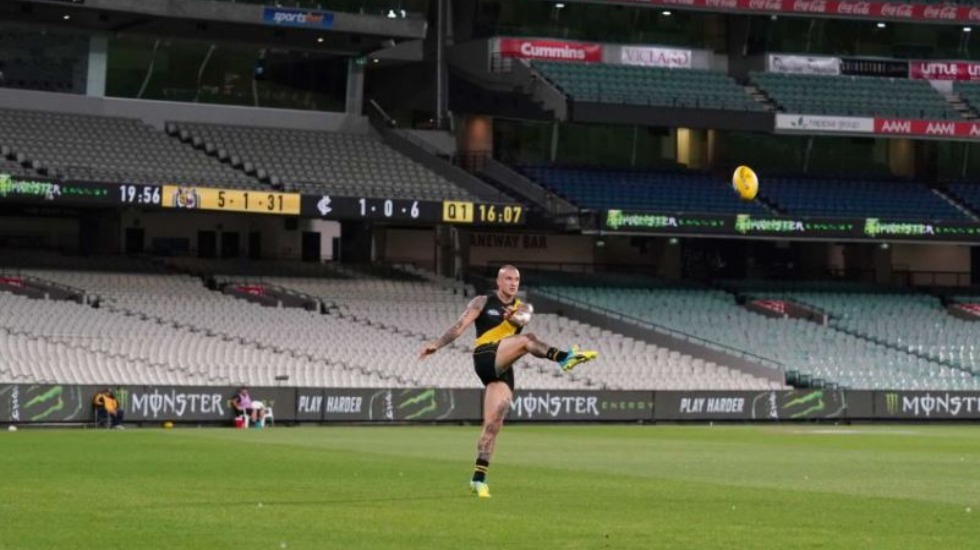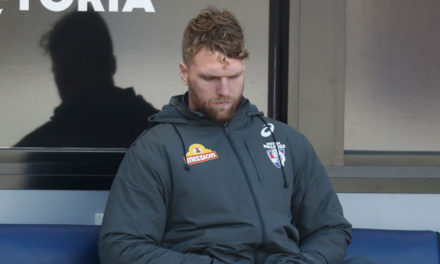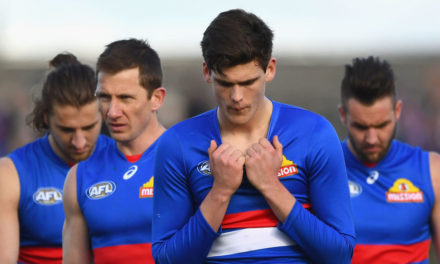Richmond’s Dustin Martin during the first game of the 2020 season against Carlton at an empty MCG. Photo: MICHAEL DODGE
From cantankerous coaches to sluggish scoring, hub escapees and logistics on the run, season 2020 will go down in the game’s annals as compromised and decidedly odd.
Future historians of the game may well ponder why the competition went ahead at all. Amidst a global pandemic, one which shows few signs of abating, questions around public health concerns and perhaps ethical ones, too, would be fair and reasonable.
Wherever you sit on the issue, it is impressive that across multiple states, governments at all levels, health officials, AFL operations staff and club executives managed to cobble together a bipartisan effort to get the show up and running again after footy was shut down between 22 March and 11 June.
The willingness of each club – players, staff, volunteers and families – to embrace a new reality of interstate hubs, quarantine regimes and flexibility of fixtures, should be commended. This is particularly in light of the drastic cost-cutting forced upon organisations as revenues shrank.
On this count, so too should we doff our hats to members, especially those belonging to West Coast, St Kilda and the Suns, clubs which experienced healthy increases in subscriptions (Gold Coast’s base grew by 19 per cent).
The overall membership base for AFL clubs did fall, but only by six per cent. With supporters realising early on that the chances of live attendance would be non-existent or minimal at best, it’s a remarkable result. Of concern, though, Essendon, Melbourne and Sydney members deserted in droves.
On the negative side of the ledger, even the most enthused fan would concede that without crowds, or without the full complement, atmosphere suffered. Likewise, shortened quarters, often dewy conditions and neutral venues took away much of what’s left of the game’s aesthetic appeal.
Let’s face it – the game was ugly. Congestion was insufferable yet entirely predictable. As line coaches and analysts developed ever more sophisticated ways to apply defensive pressure, scoring inevitably deteriorated, albeit exacerbated this season by tricky conditions and 16-minute quarters.
Teams regularly went goalless or indeed without scoring for an entire quarter. One of the flag favourites, Geelong, in round 17 against Richmond, managed a solitary major by three-quarter time. In round 13, 11 sides had scored one goal or less at quarter time.
The home and away season ended with an average team total of 60 points. Average disposals per goal climbed to 34; in season 2000 it was 20. Average tackles per game were 101; in 2000, with full quarters, the average was 67.
While much of the 25 per cent drop in average scores compared to 2019 can be pinned on reduced game times, the average winning margin decreased by only 12 per cent. One might assume the figures would more or less match.
PLEASE HELP US CONTINUE TO THRIVE BY BECOMING AN OFFICIAL FOOTYOLOGY PATRON. JUST CLICK THIS LINK.
It remains perplexing that for all the artificial equalisation measures introduced by the VFL/AFL over the last 40 years, the average margin per game has stubbornly hovered between five and seven goals. Adjusted for shorter quarters, season 2020 was no different. Ironically, margins remain higher than before the age of equalisation.
Adjudication was a red-hot topic and not without justification. Clearly, the pressure to implement technical interpretations on an already complex set of rules while under the harshest glare impacts the mental health of umpires and frustrates players and fans alike.
For all the contention around the vagaries of holding the ball, my primary concern remains the fundamental incongruity between the league’s governing body repeatedly calling for a faster game but requiring its umpires to interpret, adjudicate, explain, instruct and fastidiously position players after every alleged infringement.
When combined with the game’s on-field governance treating its participants like errant schoolboys – ruck nomination anyone? – the flow of play is needlessly hindered.
Off the field, yet again racism reared its ugly and demented head, with maestro Eddie Betts left rueful and resigned after being attacked for the umpteenth time because of the colour of his skin. Eagles icon Nic Naitanui the same. Melbourne’s Neville Jetta the same. Our game and our society are all the poorer for it.
Although match coverage was first-rate, commentary style, particularly that of Seven Network’s on-screen talent, attracted plenty of criticism. Still they persist with boyish jocularity over commentary.
Segments of football journalism plumbed new depths as tabloid reporters and TV newshounds alike raced each other to break stories and spray hyperbole around hub breaches, the antics of players’ partners, spats between club presidents and late-night mishaps.
It generated the requisite churn of outrage on social media and talkback radio; the rest of us somehow managed to get by.
Finally, a word on this year’s cellar dwellers.
North Melbourne played like a side bewildered by its diminution, whereas the Crows, for what it’s worth, appeared not so much comfortable with their predicament as accepting of the challenge.
Little wonder Adelaide emerged from the doldrums with a positive last month while the hapless Roos fell off a cliff and immediately delisted a busload of players. Essendon followed suit and there’s more to play out on that front.
For all that 2020 threw at clubs, operating with vastly reduced budgets and resources, winning invariably eased the burden. For the losers, it really was annus horribilis.












Tremendous article . So sadly true